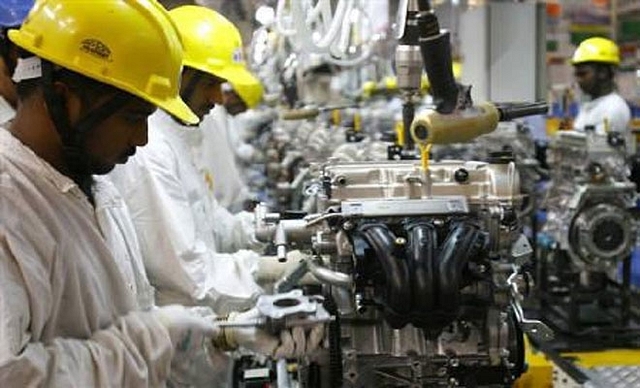
February Negative IIP Shows That Modi’s Big Challenge Remains Growth
Persistent problem—private investment is simply not rising to the challenge
The fall in the Index of Industrial Production (IIP) by 1.2 per cent in February is a negative surprise, especially when the index was positive for the previous three months – November, December and January – when the demonetisation impact was most severe.
While the numbers of the previous three months can be put down to the base effect (ie, positive growth over the lower index base in the corresponding months of the years before), February is a clear downer. This was the month when the cash crunch was gradually seen to be abating, and most businesses began reporting a gradual return to normal sales.
It is also not certain that March will be any better, for the base effect now turns more adverse. While the purchasing managers’ indices (PMIs) for manufacturing and services have hit five-month highs in March, the reality is that last year’s (ie March 2016’s) IIP number is at a high 198.7, when February 2017’s number is at 182.3. Output will have to jump 9 per cent from February to March for the IIP to report growth in the last month of fiscal 2016-17.
There is no reason to rule out this kind of leap, as both year-end window-dressing and the need to report high sales may be paramount for the corporate sector, but one cannot mistake this for real growth.
Quite clearly, the growth engines are not firing. While the negative trend in exports has been reversed over the last few months, and public spending is rising to cover the investment gap, private investment is simply not rising to the challenge. The consumption story is also under water. The April 2016-February 2017 growth in capital goods is -14 per cent.
Demonetisation impacted the consumer sector, as is evident from the sharply negative growth in cash-dependent sectors such as food and tobacco, which crashed by 21.7 per cent and 42.8 per cent in February. Discretionary spends like office and computer machinery also dived by 20.6 per cent.
Two factors can be held responsible for the weak growth in IIP, not only through the demonetisation months, but also in the two quarters before October 2016.
One is the sharp rise in bank non-performing assets (NPAs), and the corresponding corporate efforts to reduce leverage. Without a quick solution to the problem of bank recapitalisation and resolution of bad loans, revival will continue to remain anaemic. Companies stuck with high debts are hardly going to be in a rush to invest. And any resolution of bad loans may not necessarily mean an immediate rush to invest. For example, when banks forced the Jaiprakash Group to sell its cement interests to Kumar Birla, the result is not a reduction in loans, but a shift of the same loan from weak hands to strong ones. But Birla is not going to rush to invest more either as his own leverage worsens after the purchase.
Two, the government’s overdrive against black money and tax evasion cannot be helping matters. There have been three schemes to force tax evaders to pay up (one for disclosure of foreign assets in 2015, the Income Disclosure Scheme last year, and the post-demonetisation PM Garib Kalyan Yojana that closed this March). With demonetisation giving a new impetus to government efforts to extract more taxes from the non-compliant, the psychological climate is one of change from the previous tax-avoidance mindset. When you begin to think compliance, the logical fallout is more circumspection in business, and a crimp in business-as-usual expansion. While this will bring in more tax resources for the future, in the short run business will lack resources to rejuvenate itself. The introduction of the goods and services tax (GST) will also force greater tax compliance, which will slow down revival.
NDA-2’s real achievement will not be spectacular growth, but a cleansing of the system the hard way. But Narendra Modi seems to have found a way to delink trends in economic growth from his party’s electoral fortunes, unlike Atal Behari Vajpayee. Modi has combined good politics with not-so-bad economics to gain electorally. Whether this magic will last till 2019 is another matter.
However, the first quarter of this fiscal year (2017-18) is likely to bring some cheer, as consumers revive spending after restraining themselves during the demonetisation months. After that we enter the unknown territory of GST. Every piece of data will be parsed for information. The only pity is that the IIP is the wrong number to look at. It has a base of 2004-05, which means it is out of touch with today’s realities.